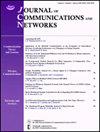AUB: A full-duplex MAC protocol for the efficient utilization of the idle uplink period in WLAN
IF 3.2
3区 计算机科学
Q2 COMPUTER SCIENCE, INFORMATION SYSTEMS
引用次数: 0
Abstract
Recently, full-duplex radio has attracted attention as a solution for wireless local area networks (WLANs) where traffic is exploding but available frequency bands are insufficient. Full-duplex radio exploits various self-interference cancellation technologies to transmit and receive signals concurrently in the same frequency band. Thus, the efficiency of the frequency band is doubled compared with that of conventional half-duplex radios. However, to effectively exploit full-duplex radio, new problems that do not exist in conventional half-duplex radio, such as full-duplex link setup, inter-node interference avoidance, and idle uplink period (IUP), must be addressed. We propose a full-duplex medium access control (MAC) protocol to effectively exploit full-duplex radio by addressing these problems. In particular, our MAC protocol uses an IUP to transmit an acknowledgment (ACK) frame and report the buffer information of nodes. Accordingly, an access point can gather the node's buffer information during the IUP and schedule the transmission of nodes without competition. In addition, because the uplink ACK frame is transmitted during the IUP, additional channel usage time for the uplink ACK frame transmission is not required. Therefore, the proposed MAC protocol improves the WLAN throughput by reducing the number of control frame transmissions and the IUP. The results of our performance analysis and simulation show that the MAC protocol achieves throughput improvements compared with those of previous studies.AUB:有效利用无线局域网空闲上行链路时间的全双工 MAC 协议
近来,全双工无线电作为无线局域网(WLAN)的一种解决方案备受关注,因为在这种网络中,通信量激增,但可用频段不足。全双工无线电利用各种自干扰消除技术,在同一频段同时发射和接收信号。因此,与传统的半双工无线电相比,频段的效率提高了一倍。然而,要有效利用全双工无线电,必须解决传统半双工无线电不存在的新问题,如全双工链路设置、节点间干扰避免和空闲上行链路周期(IUP)。我们提出了一种全双工介质访问控制(MAC)协议,通过解决这些问题来有效利用全双工无线电。特别是,我们的 MAC 协议使用 IUP 传输确认(ACK)帧,并报告节点的缓冲区信息。因此,接入点可以在 IUP 期间收集节点的缓冲区信息,并在没有竞争的情况下安排节点的传输。此外,由于上行链路 ACK 帧是在 IUP 期间传输的,因此上行链路 ACK 帧传输不需要额外的信道使用时间。因此,拟议的 MAC 协议通过减少控制帧传输次数和 IUP 来提高 WLAN 吞吐量。性能分析和仿真结果表明,与之前的研究相比,MAC 协议的吞吐量有所提高。
本文章由计算机程序翻译,如有差异,请以英文原文为准。
求助全文
约1分钟内获得全文
求助全文
来源期刊
CiteScore
6.60
自引率
5.60%
发文量
66
审稿时长
14.4 months
期刊介绍:
The JOURNAL OF COMMUNICATIONS AND NETWORKS is published six times per year, and is committed to publishing high-quality papers that advance the state-of-the-art and practical applications of communications and information networks. Theoretical research contributions presenting new techniques, concepts, or analyses, applied contributions reporting on experiences and experiments, and tutorial expositions of permanent reference value are welcome. The subjects covered by this journal include all topics in communication theory and techniques, communication systems, and information networks. COMMUNICATION THEORY AND SYSTEMS WIRELESS COMMUNICATIONS NETWORKS AND SERVICES.

 求助内容:
求助内容: 应助结果提醒方式:
应助结果提醒方式:


